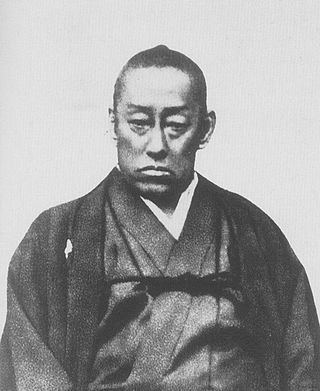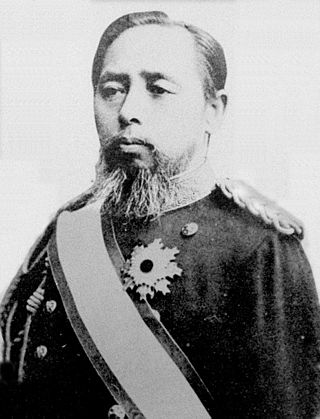Biography
Murata was born in Sawae, Misumi Village, Otsu District, Nagato Province as the eldest son of Murata Mitsukata, a 91 koku retainer of the Chōshū Domain. He attended the han school Meirinkan, where he had outstanding records, and in 1808, served as a page to Mōri Narifusa, the daimyō of Chōshū Domain. After that, he successively held important posts under the five daimyō from Mōri Narihiro to Mōri Takachika. In Edo, he further broadened his knowledge by learning the art of warfare and coastal defense from Hanawa Hokiichi and others, and economics from the writings of Kaiho Seiryō. In 1819, he inherited the headship of Murata family. [1]
In 1838, Murata took over the real power of the administration of Chōshū Domain, and concurrently serving as Omote-ban-gashira and Edo Shikakukake. Under Mōri Takachika, he worked on the financial reconstruction policy accompanying the Tenpō Reforms, an array of economic policies introduced between 1841 and 1843 by the Tokugawa shogunate under the direction of Mizuno Tadakuni. Chōshū Domain suffered from severe debts, and in 1843 Murata calculated a method of paying off the debt and interest over a 37 year period. Partly to pay for this reform, he lifted the domain's monopoly on wax and allowed merchants to trade in it freely. He also imposed taxes on shipping passing through the Kanmon Straits separating Honshu and Kyushu as well as developing a domain-owned financial and warehousing hub in the port of Shimonoseki itself. Due to his reforms, the finances of Chōshū Domain began to recover. In addition, Murata devoted his efforts to popularizing education, recommending education to the common people, and in 1849 he expanded the Meirinkan. [1]
However, Murata's reforms faced considerable opposition on many fronts. The local merchants were unhappy at increased taxes and the 37 year period over which existing debts would be slowly repaid; Osaka merchants were unhappy at the developments at Shimonoseki, fearing a decrease in the distribution of goods to Osaka. Furthermore, Mizuno Tadakuni's removal from power in 1845 led to a repeal of most of his reforms at the national level. Murata resigned after collapsing from apoplexy which resulted in partial paralysis. Although he later recovered, he devoted his efforts to education, writing a number of books. In 1855, he returned to the domain's administration, but suffered another attack of apoplexy the same year and died at the age of 73. [1] Although Murata's reforms were only partially successful, he is credited with solidifying the foundations for the Chōshū Domain to play an active role in the Meiji Restoration.

Bakumatsu was the final years of the Edo period when the Tokugawa shogunate ended. Between 1853 and 1867, under foreign diplomatic and military pressure, Japan ended its isolationist foreign policy known as sakoku and changed from a feudal Tokugawa shogunate to the modern empire of the Meiji government. The major ideological-political divide during this period was between the pro-imperial nationalists called ishin shishi and the shogunate forces, which included the elite shinsengumi swordsmen.

Mizuno Tadakuni was a daimyō during late-Edo period Japan, who later served as chief senior councilor (Rōjū) in service to the Tokugawa shogunate. He is remembered for having instituted the Tenpō Reforms.

The Mōri clan was a Japanese samurai clan descended from Ōe no Hiromoto. Ōe no Hiromoto was descended from the Fujiwara clan. The family's most illustrious member, Mōri Motonari, greatly expanded the clan's power in Aki Province. During the Edo period his descendants became daimyō of the Chōshū Domain under the Tokugawa shogunate. After the Meiji Restoration with the abolition of the han system and daimyō, the Mōri clan became part of the new nobility.

Nagato Province, often called Chōshū (長州), was a province of Japan. It was at the extreme western end of Honshū, in the area that is today Yamaguchi Prefecture. Nagato bordered on Iwami and Suō Provinces.

The Satsuma–Chōshū Alliance, or Satchō Alliance was a powerful military alliance between the feudal domains of Satsuma and Chōshū formed in 1866 to combine their efforts to restore Imperial rule and overthrow the Tokugawa shogunate of Japan.

Tenpō (天保) was a Japanese era name after Bunsei and before Kōka. The period spanned from December 1830 through December 1844. The reigning emperor was Ninko-tennō (仁孝天皇).

Hotta Masayoshi was the 5th Hotta daimyō of the Sakura Domain in the Japanese Edo period, who served as chief rōjū in the Bakumatsu period Tokugawa shogunate, where he played an important role in the negotiations of the Ansei Treaties with various foreign powers.
The Tenpō Reforms were an array of economic policies introduced between 1841 and 1843 by the Tokugawa shogunate in Japan. These reforms were efforts to resolve perceived problems in military, economic, agricultural, financial and religious systems. The changes were intended to address problems in local politics, but they were also addressed more broadly to "domestic uneasiness." The perceived need for change led to the arrest of many prominent political figures and writers. The reforms became a precursor of reforms initiated after the Meiji Restoration two decades later. This reform movement was related to three others during the Edo period: the Kyōhō reforms (1722–1730), the Kansei reforms (1787–1793) and the Keiō Reforms (1864–1867).

The Chōshū Domain, also known as the Hagi Domain, was a domain (han) of the Tokugawa Shogunate of Japan during the Edo period from 1600 to 1871.

Kokura Domain was a feudal domain under the Tokugawa shogunate of Edo period Japan, in what is now eastern Fukuoka Prefecture. It was centered around Kokura Castle in what is now Kitakyushu, Fukuoka and was ruled by the fudai daimyō Ogasawara clan for much of its history. In the Bakumatsu period and first years of the Meiji period, it was briefly known as Kawara Domain (香春藩) and then Toyotsu Domain (豊津藩).

Iwakuni Domain was a feudal domain under the Tokugawa shogunate of Edo period Japan, in what is now southeastern Yamaguchi Prefecture. It was centered around Iwakuni jin'ya and was ruled throughout its history the Kikkawa clan. Iwakuni Domain was dissolved in the abolition of the han system in 1871.

Fukuyama Domain was a feudal domain under the Tokugawa shogunate of Edo period Japan, in what is now southeastern Hiroshima Prefecture. It controlled much of Bingo Province and a small portion of Bitchū Province. It was centered around Fukuyama Castle. It was ruled in its early history by a branch of the Mizuno clan, and later the Abe clan. Fukuyama Domain was dissolved in the abolition of the han system in 1871 and is now part of Hiroshima Prefecture. It was called Bingo-Fukuyama Domain in the early Meiji period to distinguish it from Matsumae Domain, which was also popularly called "Fukuyama Domain" at the time.

Chōfu Domain was a feudal domain under the Tokugawa shogunate of Edo period Japan, in what is now part of Shimonoseki, Yamaguchi Prefecture. It was centered around Kushizaki Castle and was ruled throughout its history by a cadet branch of the Mōri clan. Chōfu Domain was dissolved in the abolition of the han system in 1871. The domain was also called Nagato-Chōfu Domain or Nagato-Fuchū Domain.
Ōta Sukemoto was the 5th daimyō of Kakegawa Domain in Tōtōmi Province, in late-Edo period and Bakumatsu period Japan and a high-level office holder within the Tokugawa shogunate, and ninth hereditary chieftain of the Kakegawa-Ōta clan. His courtesy title was Dewa-no-kami.

Tsuwano Domain was a feudal domain under the Tokugawa shogunate of Edo period Japan, in what is now western Shimane Prefecture. It was centered around Tsuwano Castle and was ruled by the tozama daimyō Kamei clan for most of its history. A number of influential persons in the early Meiji government came from Tsuwano, including Mori Ōgai and Nishi Amane.

Mōri Takachika was the 13th daimyo of Chōshū Domain. His domain was a traditional enemy of the Tokugawa shogunate, and he became a key player in its downfall during the Bakumatsu period. He was also the first daimyo to return his lands to the Emperor during the abolition of the han system. He was later allowed to use a character from the name of shōgun Tokugawa Ieyoshi and changed his name to Yoshichika (慶親).

Mizuno Tadakiyo was a daimyō during Bakumatsu period Japan, who served as chief senior councilor (Rōjū) in service to the Tokugawa shogunate.
Inoue Masaharu was a daimyō and official of the Tokugawa shogunate during late-Edo period Japan. His courtesy title was Kawachi-no-kami.

Count Yamada Akiyoshi was a Japanese politician, samurai, and one of the early leaders of the Meiji Restoration. He served as Minister of Justice from 1885 to 1891. In his youth he was commonly known as Yamada Ichinojō; however, he changed his name frequently during the Bakumatsu period.

Iida Domain was a feudal domain under the Tokugawa shogunate of Edo period Japan. It is located in Shinano Province, Honshū. The domain was centered at Iida Castle, located in what is now part of the town of Iida in Nagano Prefecture. It was also known as Shinano-Iida Domain.
















